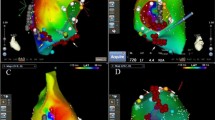Abstract
Patients with the Marfan syndrome may pose a difficult challenge for catheter-based interventions due to frequent coexisting valve disease, potential delay in vascular healing and repair, and intra-atrial scar from prior cardiac surgery. We report a case series of four patients with Marfan or Marfan-like syndromes who underwent ablation for drug-refractory atrial fibrillation. Ultimately three of four patients remained in sinus rhythm, however most patients required multiple ablative attempts and long-term atrial flutter was common. Nonetheless, peri-procedural complications were minimal despite the connective tissue disorder and prosthetic valves in three of four patients. In conclusion, catheter ablation of AF in patients with Marfan syndrome is a viable option in those individuals refractory to conventional therapy.
Similar content being viewed by others
References
Judge, D. P., & Dietz, H. C. (2005). Marfan’s syndrome. Lancet, 366, 1965–1976.
Gelb, B. D. (2006). Marfan's syndrome and related disorders - more tightly connected than we thought. New England Journal of Medicine, 355, 841–844.
De Paepe, A., Devereux, R. B., Dietz, H. C., Hennekam, R. C., & Pyeritz, R. E. (1996). Revised diagnostic criteria for the Marfan syndrome. American Journal of Medical Genetics, 62, 417–426.
Cappato, R., Calkins, H., Chen, S. A., Davies, W., Iesaka, Y., & Kalman, J., et al. (2005). Worldwide survey on the methods, efficacy, and safety of catheter ablation for human atrial fibrillation. Circulation, 111, 1100–1105.
Nataatmadja, M., West, J., & West, M. (2006). Overexpression of transforming growth factor-beta is associated with increased hyaluronan content and impairment of repair in Marfan syndrome aortic aneurysm. Circulation, 114, I371–I377.
Milewicz, D. M., Dietz, H. C., & Miller, D. C. (2005). Treatment of aortic disease in patients with Marfan syndrome. Circulation, 111, e150–e157.
Bunch, T. J., Asirvatham, S. J., Friedman, P. A., Monahan, K. H., Munger, T. M., & Rea, R. F., et al. (2005). Outcomes after cardiac perforation during radiofrequency ablation of the atrium. Journal of Cardiovascular Electrophysiology, 16, 1172–1179.
Murdoch, J. L., Walker, B. A., Halpern, B. L., Kuzma, J. W., & McKusick, V. A. (1972). Life expectancy and causes of death in the Marfan syndrome. New England Journal of Medicine, 286, 804–808.
Dujardin, K. S., Enriquez-Sarano, M., Schaff, H. V., Bailey, K. R., Seward, J. B., & Tajik, A. J. (1999). Mortality and morbidity of aortic regurgitation in clinical practice. A long-term follow-up study. Circulation, 99, 1851–1857.
Grigioni, F., Avierinos, J. F., Ling, L. H., Scott, C. G., Bailey, K. R., & Tajik, A. J., et al. (2002). Atrial fibrillation complicating the course of degenerative mitral regurgitation: determinants and long-term outcome. Journal of the American College of Cardiology, 40, 84–92.
Savolainen, A., Kupari, M., Toivonen, L., Kaitila, I., & Viitasalo, M. (1997). Abnormal ambulatory electrocardiographic findings in patients with the Marfan syndrome. Journal of Internal Medicine, 241, 221–226.
Shores, J., Berger, K. R., Murphy, E. A., & Pyeritz, R. E. (1994). Progression of aortic dilatation and the benefit of long-term beta-adrenergic blockade in Marfan’s syndrome. New England Journal of Medicine, 330, 1335–1341.
Cappato, R., Negroni, S., Pecora, D., Bentivegna, S., Lupo, P. P., & Carolei, A., et al. (2003). Prospective assessment of late conduction recurrence across radiofrequency lesions producing electrical disconnection at the pulmonary vein ostium in patients with atrial fibrillation. Circulation, 108, 1599–1604.
Pappone, C., Manguso, F., Vicedomini, G., Gugliotta, F., Santinelli, O., & Ferro, A., et al. (2004). Prevention of iatrogenic atrial tachycardia after ablation of atrial fibrillation: a prospective randomized study comparing circumferential pulmonary vein ablation with a modified approach. Circulation, 110, 3036–3042.
Gerstenfeld, E. P., Callans, D. J., Dixit, S., Russo, A. M., Nayak, H., & Lin, D., et al. (2004). Mechanisms of organized left atrial tachycardias occurring after pulmonary vein isolation. Circulation, 110, 1351–1357.
Kilicaslan, F., Verma, A., Yamaji, H., Marrouche, N. F., Wazni, O., & Cummings, J. E., et al. (2005). The need for atrial flutter ablation following pulmonary vein antrum isolation in patients with and without previous cardiac surgery. Journal of the American College of Cardiology, 45, 690–696.
de Groot, N. M., Zeppenfeld, K., Wijffels, M. C., Chan, W. K., Blom, N. A., & Van der Wall, E. E., et al. (2006). Ablation of focal atrial arrhythmia in patients with congenital heart defects after surgery: role of circumscribed areas with heterogeneous conduction. Heart Rhythm, 3, 526–535.
Robbins, I. M., Colvin, E. V., Doyle, T. P., Kemp, W. E., Loyd, J. E., & McMahon, W. S. (1998). Pulmonary vein stenosis after catheter ablation of atrial fibrillation. Circulation, 98, 1769–1775.
Packer, D. L. (2001). Linear ablation for atrial fibrillation. In D. P. Zipes, & M. Haissaguerre (Eds.) Catheter ablation of arrhythmias pp. 107–129. Armonk, NY: Futura.
Saad, E. B., Rossillo, A., Saad, C. P., Martin, D. O., Bhargava, M., & Erciyes, D., et al. (2003). Pulmonary vein stenosis after radiofrequency ablation of atrial fibrillation: functional characterization, evolution, and influence of the ablation strategy. Circulation, 108, 3102–3107.
Kok, L. C., Everett, T. Ht., Akar, J. G., & Haines, D. E. (2003). Effect of heating on pulmonary veins: How to avoid pulmonary vein stenosis. Journal of Cardiovascular Electrophysiology, 14, 250–254.
Pappone, C., Oral, H., Santinelli, V., Vicedomini, G., Lang, C. C., & Manguso, F., et al. (2004). Atrio-esophageal fistula as a complication of percutaneous transcatheter ablation of atrial fibrillation. Circulation, 109, 2724–2726.
Author information
Authors and Affiliations
Corresponding author
Rights and permissions
About this article
Cite this article
Bunch, T.J., Connolly, H.M., Asirvatham, S.J. et al. Catheter ablation for atrial fibrillation in patients with the Marfan and Marfan-like syndromes. J Interv Card Electrophysiol 20, 15–20 (2007). https://doi.org/10.1007/s10840-007-9162-5
Received:
Accepted:
Published:
Issue Date:
DOI: https://doi.org/10.1007/s10840-007-9162-5




